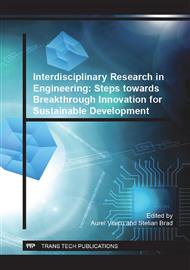p.293
p.301
p.309
p.317
p.327
p.335
p.343
p.353
p.361
Load Carrying Elements and Structural Modular Systems Made of Synthetic Fibres Reinforced Mineral Matrix Composite
Abstract:
The use of recyclable materials is a priority for the construction industry aiming to a sustainable development. Recent works have shown that calcium sulphate in the β anhydride III form which is a hydraulic binder manufactured from industrial wastes can partially replace ordinary Portland cement in construction elements. Alkali resistant glass fibres can be used as reinforcement for ecological mineral matrix in order to obtain a mineral composite material. In the framework of an extensive research program, load carrying elements and structural modular system entirely made of mineral composite material were designed, developed, tested, analyzed and implemented. The paper presents the selection of efficient mixes for a mineral matrix with convenient mechanical properties, good workability and encouraging prospects to be implemented in construction elements and full structural systems. The experimental work carried out confirms the suitability of this material for load bearing elements and modular building systems.
Info:
Periodical:
Pages:
327-334
Citation:
Online since:
June 2013
Authors:
Permissions:
Share:
Citation:


